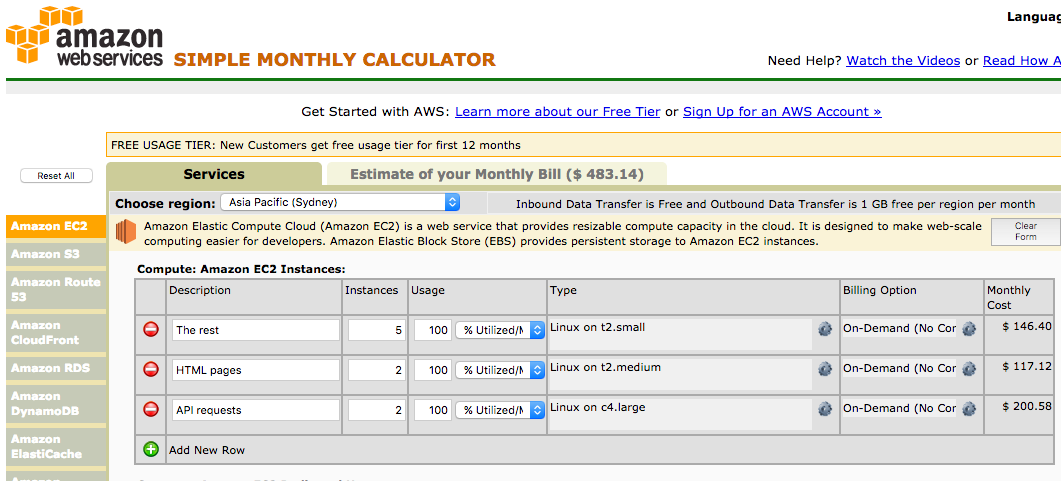
Deploying NodeJs Servers at Scale
Top 7 Things Learnt
2016 Olympics
- 5.x million users (60 min interval)
- 3.x million users (5 min interval)
- 1.x million users (1 min interval)
AWS resources
c4.large: 2X instances for API requestst2.medium: 2X instances for HTML pagest2.small: 3-5X instances for the rest- 47% CPU usage peak
... which works out to super cheap

1. Server Lifetime
- Always up vs reboot at will
- Push tasks using queues (SQS + SNS)
Delegate intensive tasks
- Always up server delegates resource intensive tasks to reboot at will servers
2. 3rd party APIs
- Always plan for them to fail
- Set up notification alerts for these
- Just logging to files is insufficient
- Learning point for us during the event
3. Excel at async IO
- Fail fast
- Leverage this by being as quick as possible
- Non-blocking -> non-slow
- Understand Javascript's event loop
- Move stuff back into the event loop ASAP
4. Asynchronous Javascript
- Low loads: Promises & callbacks had same performance
- High loads: Callbacks outperformed promises
- Small but perceptible difference
Rule of 3
- Function nest count
<= 3- Main function (route handler)
- Callback
- Nested callback
Rule of 3
function getFooRoute(req, res) { // <1>
async1(req.params.id, (err, result) => { //<2>
if (err) {
return res.status(401).send();
}
async2(result, (err2, result2) => { // <3>
if (err2) {
return res.status(404).send();
}
return res.json(result2);
});
});
}Why 3?
- Each async action has at minimum 1 fail and 1 pass state
- How hard is it to reason about states?
- 1 callback -> 2 states -> trivial
- 2 callbacks -> 4 states -> trivial
- 3 callbacks -> 8 states -> hard
More than 3
- Function is too complex -> refactor/ rewrite
- OR:
yieldcallbacks
Koa philosophy
- Stole some ideas from
koaroutes and middleware - Generator functions as the primary async mechanism
- Applied them to
express - But, without
co& withoutPromise
promises
colets youyieldPromises
co(function* () {
let result = yield myPromise;
// do something with result
})
.catch((err) => {
// handle error
});callbacks
rightolets youyieldcallbacks
righto.iterate(function* (reject) {
let [err, result] = yield righto.surely(myCallback, param);
if (err) { reject(err); return; }
// do something with result
})((err, result) => { /* ... */ });hot code
5. Hot code
- Identify it from biz rules
- Live monitoring in production
- Optimise it heavily
Hot code optimisations
- Deflect work elastically
- Multiple levels of caching
stretch!
Elastic Deflect (TM)
- For things that run very frequently
- e.g. token cycling
- Stretch the interval based on volume
- Serve the same number of users with less resources
- When the volume goes back to normal, the interval goes back to normal too
caching

Multiple levels of caching
- Cache everything
- Internally within the server:
- In memory LRU cache
- On the clients (web + native mobile apps)
- HTTP response header
Cache-Control
- HTTP response header
- On the CDN
- Configure to read from
Cache-Control
- Configure to read from
- Even cache your error responses
- (use a lower
max-age)
- (use a lower
Multiple levels of caching
- Browser, then CDN, then server
optimisations

Optimisations summary
The fastest API request/ response times that you will ever get are the ones which you never need to make
devops
6. Blue-green deployments
- Always have two production servers running
- DNS level switch (Route53)
- No down time
- Smoke test in production before users get to it
- Easy to roll back
- Deploy to production on day 2!
testing
7. Testing
- 93% code coverage
- Really gives you confidence in deploying
- Confidence is necessary if deploying after going live
- When something breaks, narrow down fault definitively
- Useful when 3rd party vendors are problematic
Test and deploy flow
- Smoke test -> Unit & integration test -> Deploy
Fin
- Very few fancy things
- A lot of getting the basic stuff right
Questions?

Brendan Graetz
@bguiz



